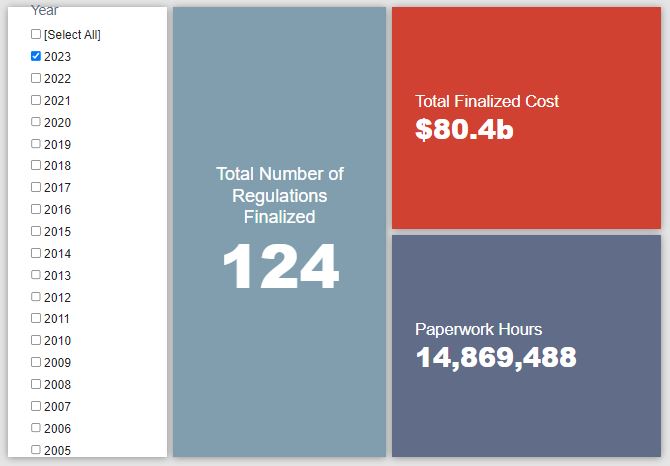Week in Regulation
August 7, 2023
Active Start to August Yields Notable Net Savings
Last week in the Federal Register was one of the more active ones in recent memory. In all, there were 27 rulemakings with some measurable economic impact. These actions ran the gamut in terms of variety in significance and topic matter. Perhaps most notable is that a pair of proposed rules – both incidentally focused on affected individuals’ online experiences – combined to yield sizeable potential time (and thus cost) savings. Across all rulemakings, agencies published $72.9 billion in total cost savings but added 5.7 million annual paperwork burden hours.
REGULATORY TOPLINES
- Proposed Rules: 33
- Final Rules: 73
- 2023 Total Pages: 51,933
- 2023 Final Rule Costs: $80.4 billion
- 2023 Proposed Rule Costs: $266.2 billion
NOTABLE REGULATORY ACTIONS
The most consequential rulemaking of the week was the proposed rule from the Department of Justice (DOJ) regarding “Nondiscrimination on the Basis of Disability; Accessibility of Web Information and Services of State and Local Government Entities.” The proposal seeks to “establish specific requirements, including the adoption of specific technical standards, for making accessible the services, programs, and activities offered by State and local Government entities to the public through the web and mobile apps.” DOJ expects the implementation of these new standards to involve roughly $20.7 billion in total costs over a 10-year period for affected state and local governments. The department also posits, however, that increasing the accessibility of these government services portals could yield time and cost savings for disabled individuals by allowing for those currently depending upon in-person interactions with government entities to enjoy a more convenient process, and by streamlining aspects of the experience for those already using online services. Based on DOJ’s preliminary estimates, this nets out to roughly $64 billion in savings over a 10-year period.
The other significant action with notable potential time savings comes from the Federal Trade Commission (FTC). This proposed rule, entitled “Trade Regulation Rule on the Use of Consumer Reviews and Testimonials,” seeks to “prohibit certain specified unfair or deceptive acts or practices involving consumer reviews or testimonials.” FTC currently estimates that the costs involved for affected entities in complying with these new standards could range from $0 to $826.3 million. On the consumer side, however, the agency estimates that the American public spends 1.7 billion hours reading online reviews each year, with approximately 10 percent of that time spent viewing fraudulent or deceptive reviews. FTC estimates that, if this proposal were to eliminate that 10 percent slice, it would represent nearly $4 billion in annual monetized savings in terms of forgone opportunity costs (or $30 billion in total when discounted across a 10-year horizon). FTC also contemplates a scenario in which consumers realize no such time savings. As such, taking the average costs minus the average savings yields $14.5 billion in total net savings.
TRACKING THE ADMINISTRATIONS
As we have already seen from executive orders and memos, the Biden Administration will surely provide plenty of contrasts with the Trump Administration on the regulatory front. And while there is a general expectation that the current administration will seek to broadly restore Obama-esque regulatory actions, there will also be areas where it charts its own course. Since the AAF RegRodeo data extend back to 2005, it is possible to provide weekly updates on how the top-level trends of President Biden’s regulatory record track with those of his two most recent predecessors. The following table provides the cumulative totals of final rules containing some quantified economic impact from each administration through this point in their respective terms.![]() While last week saw massive net savings from the pair of proposed rules discussed above, the Biden Administration’s final rule cost total ticked upward by nearly $3 billion. The primary cause of this increase was a Department of Transportation (DOT) rule establishing further accessibility standards for lavatories on single-aisle aircraft. DOT estimates that, over a 45-year horizon, such adjustments will involve $2.9 billion in total costs. For the other two administrations, there were no significant shifts. The most pronounced change was Obama-era paperwork increasing by nearly 670,000 hours, due largely to a Department of Treasury rule involving the Bank Secrecy Act.
While last week saw massive net savings from the pair of proposed rules discussed above, the Biden Administration’s final rule cost total ticked upward by nearly $3 billion. The primary cause of this increase was a Department of Transportation (DOT) rule establishing further accessibility standards for lavatories on single-aisle aircraft. DOT estimates that, over a 45-year horizon, such adjustments will involve $2.9 billion in total costs. For the other two administrations, there were no significant shifts. The most pronounced change was Obama-era paperwork increasing by nearly 670,000 hours, due largely to a Department of Treasury rule involving the Bank Secrecy Act.
THIS WEEK’S REGULATORY PICTURE
This week, the Department of Housing and Urban Development (HUD) also gets in on the fun of updating the protocols surrounding online experiences. Source: Photo by Tierra Mallorca on Unsplash
Source: Photo by Tierra Mallorca on Unsplash
Last Monday, HUD published a proposed rule regarding “Modernization of Engagement With Mortgagors in Default.” Under current HUD regulations, “mortgagees [lenders] of Federal Housing Administration (FHA) insured single family mortgages (mortgagees)” are required “to meet in person, or make a reasonable effort to meet in person, with mortgagors [borrowers] who are in default on their mortgage payment” to discuss potential “loss mitigation options.” With this proposed rule, HUD seeks to update such standards to allow for such meetings to happen via “electronic and other remote communication methods, such as telephone calls or video calls.”
Such a change has been a long time coming. As HUD notes, the original requirement dates back to 1976 and, due to market trends in the intervening years, the typical mortgagee-mortgagor relationship has changed dramatically since now most lenders “have a national presence and often employ a single national servicing center or a limited number of regional servicing centers, operate without retail places of business altogether, and tend to conduct origination and servicing activities with employees and clients not being in close physical proximity.” As such, it is often more difficult for either party to meet this “face-to-face” requirement.
While it seems that HUD has been contemplating this update for some time, it appears that – as in so many other areas of life – the COVID-19 pandemic has helped spur the agency to make such updates official and permanent. In light of the obvious health implications of requiring a face-to-face meetings during the height of the pandemic, HUD provided affected parties with a series of temporary waivers that allowed for these meetings to take place electronically; these waivers remain operative through the end of this year. Unsurprisingly, the update “received positive feedback from mortgagees and consumer advocates related to the added flexibility to existing loss mitigation outreach requirements permitted by the waiver.”
HUD does not provide a quantified estimate of this proposal’s potential impacts, but notes that it “would have a net positive economic impact on mortgagees by reducing the expenses associated with making an in-person visit to a mortgagor’s property.” Add this rulemaking to the growing file of such actions, many of which were revealed through temporary pandemic-related changes, that represent all-too-easy, common-sense ways of leveraging technological advances to help make important economic interactions more convenient.
Interested parties have until September 29 to submit any further comments on the matter.
TOTAL BURDENS
Since January 1, the federal government has published $346.5 billion in total net costs (with $80.4 billion in new costs from finalized rules) and 162.7 million hours of net annual paperwork burden increases (with 14.9 million hours in increases from final rules).










